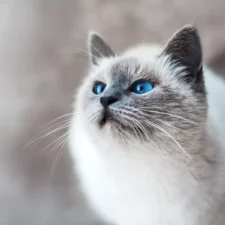Attention, feline fans: Meet the new kitty in town! The Salty Licorice Cat wears a gorgeous coat that is in line with current fashion trends. These kittens have ombre, or gradient, colored fur that is black at the roots and white at the ends. Continue reading to learn more about this lovely kitten from a local Jensen Beach, FL veterinarian.
Why is Fluffy known as the Salty Licorice Cat?
The cats are named after a popular Finnish food. As you might expect, it’s made of licorice dusted with salmiak salt. The treat, sometimes known as salmiak liquorice or salmiac licorice, is widely popular in Scandinavia, the Benelux region, and northern Germany.
Is the Salty Licorice Cat a new cat breed?
Fluffy has not yet been designated a new breed. The name describes her coat color. This is also true for many other types of cats, like tabbies and tuxedos.
Where Did The Salty Licorice Cat Come From?
Fluffy is from Petäjävesi, a village in Finland. The town is located in a lovely setting famed for its lakes, farmlands, and an 18th-century wood-log church—or maybe we should say it was once known for such things. Now, the town will have to include the Salty Licorice cat on its listings of famous locals, must-see sights, and fascinating locals. Salmiak cats are descended from stray and feral cats in the surrounding area.
What Does A Salty Licorice Cat Look Like?
These kittens are also known as salmiak cats, which translates to salty licorice cat. Fluffy resembles a tuxedo cat, save that the dark areas of her coat are flecked with white. While Salmiak cats’ darker fur is frequently black, Fluffy’s color palette is not limited to that. Salty Licorice kitties can sport the distinctive pattern with blue, brown, or tortoiseshell coats. Their tails are usually white or partially white. Fluffy’s eyes are typically a beautiful green or yellow color.
When Was The First Salty Licorice Kitty Born?
We don’t know who first found or adopted the Salty Licorice Cat or how long it has been around. Fluffy first began to garner attention in 2007, when people noticed that some of Petajavesi’s cats were highly forward-thinking in terms of their style.
At first, no one knew if the kitties would be able to breed because all of the stray cats with that unusual coloration had been fixed. The mystery has now been addressed, as one was seen giving birth to some very adorable kittens.
Who Discovered the Salty Licorice Cat?
Hannes Lohi, a geneticist at the University of Helsinki, is credited with spearheading the formal research, which was conducted by geneticists and animal welfare campaigners.
Which Gene Is Responsible for Salty Licorice Coat Colors?
Lohi’s team conducted tests on five Salty Licorice cats. They discovered that none of the cats possessed the precise gene mutations that are normally responsible for white fur. These changes are also strongly related to deafness, which explains why such a large proportion of white dogs have hearing loss. They then sequenced the cats’ whole genomes and discovered a unique mutation. The mutation affects a specific gene known as KIT.
To pinpoint the genetic cause, the researchers sequenced the entire genome of two of the cats and uncovered a previously undiscovered mutation that affects a specific gene known as KIT, which is also responsible for piebald patterns in horses and other animals. The team subsequently expanded the study, evaluating not just the five Salmiak cats but also 178 others who wore normal coats. All of the Salmiak kittens carried two copies of the responsible gene variation, which is now known as w-sal, or salmiak. Several of the other felines had one copy. Because the gene is recessive, none of the carriers could wear the Salmiak hues and patterns.
The findings were published in May in the journal Animal Genetics.
Is Licorice Safe for Cats?
Licorice isn’t a treat we’d endorse. However, it poses no threat to our feline companions. In fact, research indicates that it has anti-inflammatory qualities and could potentially help kitties with respiratory problems. However, more research is needed. In any case, you should never give your pet any herb or prescription unless specifically instructed to do so by your veterinarian.
Putting that aside, some cats appear to enjoy the flavor of licorice. Fluffy is more likely drawn to the texture or aroma, though. Cats possess a DNA abnormality that prevents them from tasting sweetness. Of course, some of these tiny furballs appeared to have missed the notice, as kitties have been known to adore foods like cake, cookies, and donuts. Fluffy most likely prefers the fat content. While it may be fun to share a donut with your furry friend, it is best to refrain from giving your cat any sweet foods. Not only are they heavy in sugar, but many include xylitol, often known as birch sugar, which is hazardous to felines.
What is The History Of Salty Licorice?
Salty licorice is extremely popular in Finland. These little black candies first gained popularity in the 1800s. Danish candymakers Galle and Jessen are credited with creating and launching what has undoubtedly become a long-lasting food phenomenon. Curling up with a purring cat and a dish of chocolates on a snowy night seems quite comfortable!
You may find a variety of recipes online. These are essentially minor variations on the same basic concept.
A common version would include the following ingredients:
- 8 tablespoons unsalted butter
- 1 cup sugar
- 1/2 cup dark corn syrup
- 1/2 cup sweetened condensed milk
- 1/4 cup blackstrap molasses
- 1/8 tsp kosher salt
- 3/4 cup whole wheat flour
- 1 1/2 tbsp anise essence
- 1 1/2 tsp black food coloring
Combine butter, sugar, milk, molasses, and salt in a saucepan. Bring to a boil. Then remove from the heat then add the remaining ingredients. To make a healthy version, substitute heavy cream for condensed milk and brown rice syrup for dark corn syrup. Pour onto a pan lined with parchment paper and let cool for 30-45 minutes, remove and shape it. Remember to sprinkle it with salt!
If you want to make these goodies, you might as well go the extra mile and get a mold to make it kitty-shaped. In fact, several candy businesses already do this!
Are Salty Licorice Cats Expensive?
For the moment, it’s hard to say. These pretty cats are still quite uncommon. However, while they are cute, as animal lovers, we must raise awareness about the drawbacks of the designer breed trend. There are plenty of sweet, affectionate felines in shelters simply waiting for a home! We always encourage people to adopt instead of shop. Our feline companions make excellent pets, regardless of the colors they wear!
Book An Appointment At Your Jensen Beach, FL Pet Clinic
Does your feline companion require an examination, vaccines, or parasite control? Has it been a long since your cat came in? Please feel free to contact us, your local Jensen Beach, FL pet hospital, for all of your cat’s veterinarian care requirements. We’re here to help.











